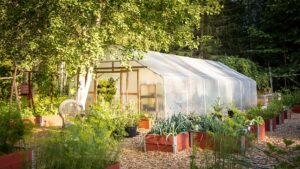March heralds the commencement of spring, it’s the perfect time to sow a variety of seeds that flourish in the coming months. But what are the best seeds to plant in March? Spinach, peas, and lettuce can confidently be planted, as they thrive in the cool soil of early spring. For those who might encounter a late frost, starting tomatoes and peppers indoors keeps them safe until warmer weather permits outdoor transplantation. Additionally, hardy annuals, such as calendula and sweet peas, can be sown directly into the soil, adding a splash of color to your garden as the season progresses.
Vegetables to Plant in March
Peas (Pisum sativum) are a cool-season crop ideal for a March planting. They should be sown directly into the soil as soon as it is workable because they germinate well in cool temperatures. Peas prefer well-drained, fertile soil and require full to partial sunlight. With their sweet flavor and versatility, they make a rewarding addition to any spring garden.
Spinach (Spinacia oleracea) is another excellent vegetable to plant in March due to its cold-hardiness. This leafy green can be planted directly into the garden as soon as the soil is workable. Spinach thrives in nutrient-rich soil with good drainage and prefers full sun, though it can tolerate partial shade. It’s a fast-growing plant, so you can expect to harvest your spinach as early as five to seven weeks after planting. Enjoy it fresh in salads, cooked in dishes, or even blended into smoothies.
Radishes (Raphanus sativus) are yet another great candidate for a March planting. These crisp root vegetables are known for their quick growing cycle, often ready to harvest in as little as three to four weeks after planting. Radishes are adaptable to many soil types, although they prefer loose, well-drained soil rich in organic matter. Sow radish seeds directly into the garden in a sunny spot and enjoy a range of dishes from fresh, crisp radish salads to beautifully roasted sides.
Lettuce (Lactuca sativa) is a resilient leafy green to plant in March, perfect for early spring salads. This cool-season vegetable prefers the milder temperatures of spring and can be sowed as soon as the soil can be worked. It grows best in loose, cool, well-drained soil and benefits from consistent moisture. Lettuce comes in various types, from crisp romaine to delicate butterhead, each with its distinct taste and texture. For a continuous harvest, practice succession planting every two weeks. Enjoy fresh, homegrown lettuce leaves in sandwiches, wraps, or a classic green salad.
Best Herbs to Plant in March
Parsley (Petroselinum crispum) is a versatile herb that can be sown in March, enriching gardens with its vibrant green foliage and fresh, clean flavor. This biennial herb prefers to grow in cooler temperatures and can be planted in rich, moist soil that also drains well. Parsley is more than just a garnish; it’s packed with vitamins and brings a bright, slightly peppery taste to a variety of dishes such as soups, salads, and pasta. Start parsley indoors or directly in the garden and expect to see sprouts in three to four weeks. Remember, parsley has a longer germination period compared to other herbs, so patience is key.
Chives (Allium schoenoprasum) emerge as a top pick among the herbs to plant in March, with their delicate onion flavor making them a staple in culinary use. This perennial herb thrives in full sun but will tolerate partial shade, and benefits from well-drained soil. Its grass-like leaves are not only a delight in dishes such as baked potatoes, soups, and omelets, but its purple flowers also add a pop of color to any herb garden. Chives are a low-maintenance herb that can be sown directly outdoors in early spring. Once established, they can be easily propagated by division to expand your garden.
Cilantro (Coriandrum sativum), also known as coriander or Chinese parsley, is another must-have herb for early planting. This annual herb appreciates cooler weather and should be planted in well-draining, loamy soil with full to partial sunlight exposure. Offering a unique, pungent flavor that is both citrusy and spicy, cilantro leaves are commonly used in a variety of culinary traditions, including Latin, Asian, and Indian cuisines. Sow the seeds directly into the soil and expect germination within 1 to 2 weeks. To maintain a steady supply, consider succession planting every few weeks as cilantro tends to bolt and set seeds quickly once the temperatures rise.
Best Flowers to Plant in March
Sweet peas (Lathyrus odoratus) are a quintessential spring flower known for their fragrant blossoms intricately climbing trellises and fences. Ideal for a March sowing, these annuals favor a sunny position with well-drained soil, and they avidly climb towards the light with a boundless zeal. Sweet peas come in a myriad of colors, and their delightful perfume adds a touch of olfactory bliss to any garden space. It is advisable to sow sweet pea seeds in deep pots to accommodate their long root systems, and provide support such as trellises or stakes early on to help guide their eager growth. With regular deadheading, you’ll be rewarded with a continual display of flowers well into summer.
Pansies (Viola tricolor var. hortensis) are another vibrant choice for early spring planting. Renowned for their charming, multi-colored faces, pansies can handle the unpredictable temperatures of early spring, often surviving light frosts. They are perfect for adding a splash of color to garden beds, containers, and window boxes, especially in areas that have yet to warm up fully. For best results, plant pansies in moist, humus-rich soil that is well-drained, and place them in an area that receives full to partial sunlight. These hardy flowers are eager to impress and will bloom most profusely in cooler weather, offering an early glimpse of the colorful season ahead.
Marigolds (Tagetes spp.) are widely cherished for their bright, cheerful flowers that are simple to grow and capable of thriving under a variety of conditions. These sunshine-hued blooms, ranging from vibrant yellows to deep oranges, are as practical as they are pretty, often used as companion plants to deter pests in vegetable gardens. The distinctive, pungent aroma of marigold foliage is unappealing to many insects, making them a natural and attractive form of pest control. For planting in March, choose a sunny spot with well-drained soil, and consider starting them indoors if the risk of frost persists. Once established, marigolds are drought-tolerant, though they appreciate regular watering during prolonged dry periods. With their reputation for easy care and prolific blooming, marigolds are an excellent addition to the spring garden palette.
Best Fruits to Plant in March
Strawberries (Fragaria × ananassa) are a favorite among backyard gardeners, especially in warmer climates where the ground thaws early. These sweet, red jewels are perennial plants that reward with plump, juicy fruits when given the proper care. For a successful March planting, select a site with full sun exposure and well-draining soil rich in organic matter. Strawberries prefer slightly acidic soil, and ensuring good air circulation around the plants can help prevent fungal diseases. These luscious berries can be grown in traditional garden beds, raised beds, or even in containers, making them versatile for any space. With their white blossoms and steadily ripening fruit, strawberries not only add beauty to your garden but also herald the promise of summer desserts to come.
Best Seeds to Start Indoors in March
Starting seeds indoors before the last frost can give you a head start on the growing season. Here are some seeds ideal for indoor planting in March:
Vegetables
Tomatoes
Tomatoes (Solanum lycopersicum) are one of the most popular vegetables to start indoors in March. With a plethora of varieties ranging from tiny cherry tomatoes to large, meaty beefsteaks, there is a type to suit every palate and purpose. When starting tomatoes indoors, use a light soil mix and keep the seedlings warm and well-lit to promote strong, stocky growth. It’s crucial to wait until all danger of frost has passed before transplanting them outdoors, allowing the soil to warm up adequately. Proper spacing and staking can help ensure good air circulation and support the plants as they grow and bear fruit. With the right care, your tomato plants will flourish and provide a bountiful harvest.
Peppers
Peppers (Capsicum spp.) are another group of plants that greatly benefit from an early start indoors. Ranging from sweet bell peppers to fiery hot varieties, peppers need a significant amount of time to mature and produce fruit. Starting peppers in March indoors allows them to develop robust root systems and foliage by the time they are transplanted outside. They thrive in warm soil and require consistent moisture for optimal growth. To ensure your peppers have sufficient time to yield a generous harvest, provide them with a warm, bright spot indoors and transplant them after the threat of frost has passed and the soil temperature is adequately warm.
Herbs
Basil
Basil (Ocimum basilicum) is a highly aromatic herb valued for its flavorful leaves, often a staple in Italian and other Mediterranean cuisines. This tender plant is sensitive to cold, which makes starting it indoors in March an excellent choice. By sowing basil seeds in a warm, well-lit area, gardeners can give them a head start, ensuring that the seedlings are sturdy enough to withstand the transition outdoors once the risk of frost has abated and the evenings are warmer. Regular harvesting of the leaves will encourage a bushier growth and prevent the plant from flowering, which can cause the leaves to lose their desirable flavor.
Sage
Sage (Salvia officinalis), known for its earthy aroma and culinary as well as medicinal uses, is yet another herb that benefits from being started indoors. Planting sage seeds in March allows them ample time to grow into hearty plants, prepared to make the transition to the garden. Like basil, sage requires a warm and sunny environment to prosper. Indoor sowing ensures that the young plants are well-established, and it allows them to develop the resilience necessary for outdoor conditions. Once the soil has warmed and the chance of a frost is long gone, your sage plants will be ready to enhance your garden with their fragrant presence and can be used to add depth to a wide variety of dishes.
Flowers
Sunflowers
Sunflowers (Helianthus annuus) are cheery and bold, known for turning their large heads to follow the sun throughout the day. While they are typically sown directly into the ground, starting sunflowers indoors can offer them a safeguard against early spring pests and ensure a strong start for these towering blooms. By planting sunflower seeds in pots indoors, gardeners can control the environment more closely, providing warmth and plenty of light to nurture young seedlings. Once frost danger has passed and the seedlings become robust enough, they can be transplanted outside where they can continue to grow into the iconic, sunny beacons of the summer garden.
Zinnias
Zinnias (Zinnia elegans) add a vibrant burst of color to any summer garden. To give these bright, daisy-like flowers a head start, sow them indoors a few weeks before the last frost date. They’re easy to transplant and will readily adapt to outdoor conditions. Once settled in the garden, zinnias will bloom profusely throughout the summer months, attracting bees, butterflies, and other pollinators to your outdoor space. Their wide range of colors and sizes make zinnias a versatile choice for both borders and floral arrangements.
Note: The suitability of these seeds can vary based on regional climate and specific weather patterns for the year.


